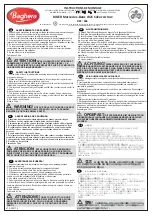
59
15. Troubleshooting
Even though the model and the remote control system were built with the latest available technology, there can still
be malfunctions or errors. For this reason, we would like to give you some information on how to deal with possible
problems. Also observe the enclosed operating instructions for the remote control system.
The model doesn’t respond or does not respond properly
• The speed controller recognises the transmitter‘s neutral position only within a specific range. If the trim at the
transmitter is misadjusted too far, the speed controller will not react for safety reasons. In this case, switch off the
speed controller and correct the trim at the transmitter (put the trim for the driving function to the centre position).
Then switch on the speed controller again.
• For 2.4 GHz remote control systems, the receiver must be taught to the transmitter. This process may be referred
to by the terms of „Binding“ or „Pairing“. The teaching process usually was performed by the manufacturer already;
however, it can, of course, also be done by you. Also observe the separately enclosed operating instructions for the
remote control system.
• Are the vehicle drive battery or the batteries/rechargeable batteries in the transmitter discharged? Exchange the
drive battery or batteries/rechargeable batteries in the transmitter for new ones.
• Depending on the drive battery used, the corresponding battery type (e.g. LiPo) must be programmed. Depending
on battery type, the speed controller uses the required undervoltage recognition (e.g. at one LiPo battery, the speed
controller switches off the motor at a battery voltage of 6.0 V (this means a voltage of 3.9 V per LiPo cell). The LED
on the speed controller flashes green in this case.
At incorrect programming of the battery type, the speed controller may switch off too late, which will lead to deep
discharge of the connected rechargeable battery.
• Did you switch on the transmitter first and then the speed controller? The speed controller will not work for reasons
of safety in case of reverse order.
• Is the drive battery connected to the speed controller correctly? Check the plug connection for whether it is conta
-
minated or oxidised.
• Is the vehicle too far away? With a fully charged drive battery and fully charged batteries/rechargeable batteries
in the transmitter, the range should be at least 50 m. The range can be decreased by outside influences, such as
interference on the transmitter frequency, or proximity to other transmitters (not only remote controller transmitters
but also WLAN/Bluetooth devices that also use a transmission frequency of 2.4 GHz), metal parts, buildings, etc.
The position of transmitter and receiver aerial to each other very strongly influences range. It is best when both the
transmitter and receiver aerial are vertical. If you point the transmitter aerial at the vehicle, the range will be very
short!
• Check the correct position of the speed controller and steering servo plugs in the receiver. If the plugs are inserted
rotated by 180°, the speed controller and steering servo will not work.
If, however, the speed controller and steering servo plugs are swapped, the throttle/brake lever controls the steering
servo, and the wheel controls driving!
• The speed controller has an overtemperature protection (at approx. +95 °C). If it was activated, wait until the speed
controller has cooled off sufficiently again.
• If the speed controller does not receive any valid signal from the receiver, it will switch off the motor for reasons of
safety. In this case, the LED on the speed controller remains lit green.
Summary of Contents for 49 01 27
Page 122: ...122 ...
Page 123: ...123 ...
















































